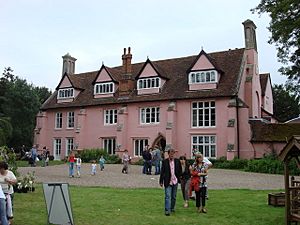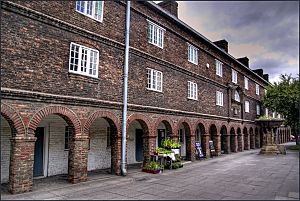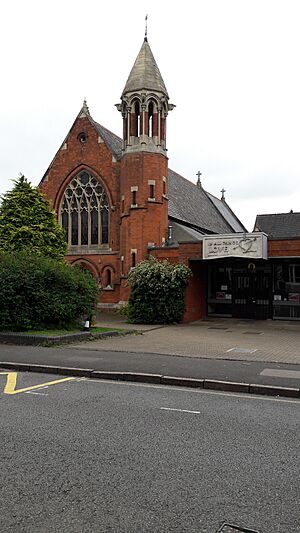Augustinian Province of England and Scotland facts for kids
The Augustinian Province of England and Scotland is a special group for the Order of Saint Augustine. It brings together all the work done by Augustinians in England and Scotland. Think of it like a regional office for a big club!
Contents
The Augustinians: Who Are They?
The Order of Saint Augustine is a Roman Catholic religious group. It started in the 1200s. Their way of life is based on the teachings of St. Augustine of Hippo. You can find Augustinians in many countries worldwide. They are in Europe, Australia, and the Americas.
A Look Back: Augustinian History
How They Started in England
The Augustinians first came to England in 1248. People in medieval England called them the "Austin Friars." A rich man named Richard de Clare, who was the Earl of Gloucester and Hertford, offered them land. This land was in Normandy, France, but it led to their first home in England.
Clare Priory became their very first place in the English-speaking world. More homes opened quickly after that. In 1253, they settled in London. Their London home, called "Austin Friars", became the most important one in England.
The priory at Clare was a quiet place for prayer. The London home showed their desire to spread their faith. Later, they opened homes in university cities. These were Oxford (in 1266) and Cambridge (in 1289). This showed how much they valued learning and high-quality studies.
At first, the English homes were part of the French Augustinian group. But by 1265, England became its own separate group. It had its own leader, called a prior provincial. All these groups answered to the main Augustinian leader. In 1291, the Holy Jesus Hospital was started in Newcastle upon Tyne. This place was like a guesthouse for travelers. It was on a main road going north. Today, parts of the old church wall from the 1300s are still there.
By 1300, the Austin Friars had 22 homes in Britain. They also had five homes in Ireland. These Irish homes were mostly run by English Augustinians. More homes opened in England, reaching 34 by the end of the 1300s. At their biggest in 1350, there were over 700 friars. But their numbers went down. By 1538, there were only 317 members. Some friars, like John Stone, Martin de Condres, and Paul of Saint William, died for their beliefs. They stood by the Pope when Henry VIII wanted to be the head of the church.
Some famous writers were part of this group. They included the poet Osbern Bokenham. There was also John Capgrave, who wrote about the Bible and history. Myles Coverdale helped translate the Bible. And William Flete was a spiritual guide to St Catherine of Siena.
Augustinians in Scotland
In 1260, there was an Augustinian home in Berwick-upon-Tweed. This town was part of Scotland back then. Robert the Bruce, a famous Scottish king, even gave money to build a new Augustinian church.
Augustinians in Wales
Around 1344, Ralph Stafford, 1st Earl of Stafford started an Augustinian home in Stafford. Later, another home opened in Newport, Wales. They also had a hospital there.
Coming Back: The Restoration
After a difficult time, some people tried to bring the Augustinians back. These individuals came from Spain, Rome, and Ireland. Finally, with help from the Irish Augustinians, they made a new start. This happened in the late 1800s.
The first lasting home since the Reformation was St Monica’s, Hoxton Square. It opened in 1864. Then came Our Lady of Good Counsel, Hythe (1891), and St Augustine's Church, Hammersmith (1903). These communities grew stronger.
In 1948, the Augustinians took over a church in Dundee, Scotland. This return to Scotland helped the English and Scottish group grow again. In 1951, a new school called Austin Friars opened in Carlisle, England. It started as a boarding school for boys. Today, it teaches both boys and girls who attend during the day.
Clare Priory, their very first home in Britain, was bought back. It became a training center for new Augustinians. In 1970, the first Augustinian meeting in England since 1532 happened at Clare. The 1970s saw even more growth. They started churches in Woodvale, Southport, and Great Yarmouth. In 1973, the friars took over St Mary's Church, Harborne, in Birmingham.
Because of this growth, and with help from the Irish Augustinians, the English and Scottish group became a full "Province" in September 1977. This meant they were a complete, independent unit. Fr Bernard O’Connor became their first leader. Saint John Stone, who died for his faith under King Henry VIII, was named the special patron of this new group.
Augustinians Today
As of 2024, there are four Augustinian communities in the UK. These are St. Mary's in Harborne, Clare Priory in Suffolk, St Augustine's Church, Hammersmith, and St Monica's Church, Hoxton.
About 20 Augustinian Friars work in the UK. They do many different jobs. This includes helping in prisons and working as chaplains at universities. Clare Priory is a church and a place for spiritual retreats. It also has a special place dedicated to Our Lady, Mother of Good Counsel.
There is also a group of Augustinian Canonesses at Boarbank Hall in Cumbria. These are Augustinian nuns.





